India’s conservative investors, particularly the ones in smaller towns, are milking the country’s booming stock markets.
After years of putting their money in unproductive assets like gold and less tax-efficient instruments, including bank deposits, these investors are gravitating towards mutual funds and stock markets. In fact, a recent boom in mutual fund investments in India was fuelled by investors from tier-2 and tier-3 towns such as Ranchi, Siliguri, Jabalpur, Bhavnagar, Coimbatore, and Nashik, according to a new report by Karvy Private Wealth, a wealth management firm. Mutual funds are an investment option where money is pooled in from various investors and put in stocks, bonds, and money-market instruments on their behalf.
In the 2017 financial year (April 2016-March 2017), mutual fund investments grew at about 40%, significantly faster than the 13% growth recorded in the previous financial year. And much of this was a result of better distribution and improved customer awareness which has managed to draw in more Indians, especially from smaller towns and cities. In the last financial year, the BSE’s benchmark equity index surged 17%.
These non-metro investors are also seeking out more complex financial instruments. “We are also witnessing greater interest for alternate investment funds such as private equity and real estate funds, among others, in smaller towns and cities across the country,” the report said.
Apart from mutual funds, investments in direct equity has also surged. In fact, overall, it was the main driver of wealth creation in the last financial year, up 26.8% compared to the previous year. In fiscal 2017, Indians invested Rs8 lakh crore ($124.16 billion) in stocks compared to Rs3.4 lakh crore in bank fixed deposits (FDs), the preferred instrument in the previous year.
“Equity has emerged as the favoured asset class in FY17 with individual investors cashing in on the current bull run of the equity markets,” Abhijit Bhave, CEO of Karvy Private Wealth, said in the report. “Apart from the outperformance of equities, a host of structural reforms implemented by the government are encouraging Indian individuals to hold wealth in financial assets.”
Yet, most of the wealth owned by Indians in financial instruments is still in fixed deposits (FDs), which stood at Rs40.1 lakh crore at the end of financial year 2017. Equity investments, though, are steadily closing the gap and stood at Rs37.6 lakh crore in financial year 2017.
Also, the love for the yellow metal in the world’s second-largest gold consumer market is slowly declining. Demand took a significant hit after the note ban in late 2016. Still, Indians continue to hold a significant amount of gold, totalling Rs68.45 lakh crore at the end of financial year 2017. This was higher than equity investments or FDs, according to the report.
Meanwhile, Indians are accumulating wealth at a faster pace. In 2017, the total wealth held by Indians grew at 11% to Rs344 lakh crore, more rapidly than the 8.5% growth recorded in the previous year. Over the next five years, this is expected to double to Rs639 lakh crore, growing at an annual rate of 13%.
